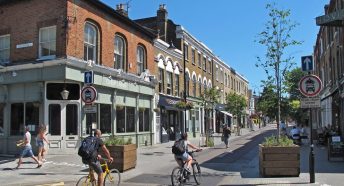‘Tarmac and be damned’: road building cannot continue post-lockdown
Being a countryside campaigner can often feel like fighting a losing battle against the persistent loss of landscapes to ever more ambitious road building programmes that slice up some of our most pristine landscapes. But it doesn’t have to be this way – the coronavirus pandemic has offered us a glimpse into what life would be like if the private car was not king.
Right now, we are witnessing a revolution on our streets. More people are now choosing active travel options like walking and cycling where possible, which has resulted in record low air pollution levels and blissfully liveable neighbourhoods. So too are green spaces and our countryside seeing a renaissance. This begs the question: how can the government continue to pursue a road building agenda guided by ‘tarmac and be damned’ top-down thinking?
Over the past 70 years, it has taken the combined might of many democratic levers and people power to designate the very best parts of our countryside as National Parks or Areas of Outstanding Natural Beauty (AONBs). These are the exceptional landscapes whose distinctive character and natural beauty are precious enough to be safeguarded in the national interest.
So, you’d have thought it was obvious that these are the parts of our much-loved countryside where you might avoid building new roads. Surely now the balance has shifted and the importance of these spaces for our health and wellbeing – a natural health service as it is now being called – means that building a road through any of them would be unthinkable? Especially as all the evidence of the past 30 years shows building new roads actually makes traffic problems worse, continues to fuel the climate emergency and drives up toxic levels of air pollution.
Unfortunately, your assumptions would be wrong. The government seems genuinely surprised that the public is not convinced by the need to smash a new road through:
- Parts of the South Downs National Park for a new A27 Arundel Bypass and a Chichester Bypass; or
- The Chilterns AONB for a, supposedly, vital A6-M1 link; or
- The Peak District National Park for an M60-M1 link road and the A628 Mottram Bypass; or
- Stonehenge (isn’t that a world-famous heritage attraction that all international tourists flock to?) for the dualling of the A303.
The list goes on. There are also a lot of other parts of our countryside currently being threatened by new roads for which the business case is suspect. Much of this comprises green space and woodlands dearly loved by their local communities, being ridden roughshod over by the government’s out-of-date transport policy. Two of the most heart-breaking examples I know of are Rimrose Valley in Lancashire and the Penny Pie Park in Barnsley. Quite rightly, all these proposals are being hotly contested by local people, supported by concerned national bodies such as CPRE, the countryside charity, and Friends of the Earth.
But the situation is likely to get worse with the £27 billion Roads Investment Strategy still in the pipeline. If even just a fraction of this money was spent on providing reliable and affordable public transport, walking and cycling, the government would help many more people, especially those who haven’t had access in the past, to enjoy the best parts of our countryside without driving.
As we emerge from the coronavirus pandemic, we need a dramatic rethink on transport policy and visionary leadership on when and where other benefits to society outweigh the need to provide space for the private car. This starts with scrapping £27 billion Roads Investment Strategy immediately and diverting that money to areas that improve people’s lives, rather than pollute them. Only then can we claim to be valuing and enhancing our world famous National Parks, AONBs and the much-loved green spaces in-between.





